#Italian port city
Text
And if i said i love the hbo Hightower’s Irish catholic vibe but i wish they were a bit more Italian about it, what then? like please they live in a port city in a big fuckass dramatic white tower with streets full of holy men/women and scholars and people come from all over the world to explore this hub of arts and sciences and religion and damn you know what else there are so many beautiful flowers the air smells like perfume. Sorry but Oldtown is so Florence-coded these bitches are Mediterranean let them wear some gaudy outfits and have a parade
#alicent hightower#gwayne hightower#otto hightower#house hightower#asoiaf#hotd#the somber Irish Catholicism feel maybe works better for this story tho#idk#edited bc yes actually italian is more correct
555 notes
·
View notes
Text
Since the early days of British involvement with Zionism, Churchill sanctioned the dispossession of non-Jewish Palestinians by assuring that they have no voice in the affairs of their own land. “In the interests of the Zionist policy,” he stated in August 1921 as the government minister in charge of Britain’s colonies, “all elective institutions have so far been refused to the Arabs.”
A snapshot of Churchill’s stances on Palestine and race is found in the records of the 1937 Peel Commission hearings, convened to address a major revolt in Palestine. [...]
Horace Rumbold [...] asked whether Zionist policy is worth “the lives of our men, and so on.” And did it follow, he asked Churchill, that having “conquered Palestine we can dispose of it as we like?”
Churchill replied to that and similar questions by invoking commitments given when Britain captured Palestine toward the end of 1917. “We decided in the process of conquest of [Palestine] to make certain pledges to the Jews,” Churchill said.
Apparently skeptical, the head of the commission, William Peel, asked Churchill if it is not “a very odd self-government” when “it is only when the Jews are a majority that we can have it.”
Churchill responded with a blunt argument of might: “We have every right to strike hard in support of our authority.”
The historian Reginald Coupland nonetheless told the hearings that the “average Englishman” would wonder why the Arabs were being denied self-government, and why we had “to go on shooting the Arabs down because of keeping his promise to the Jews.”
Peel, similarly, asked Churchill if the British public “might get rather tired and rather inquisitive if every two or three years there was a sort of campaign against the Arabs and we sent out troops and shot them down? They would begin to enquire, ‘Why is it done? What is the fault of these people?… Why are you doing it? In order to get a home for the Jews?’”
“And it would mean rather brutal methods,” added Laurie Hammond, who had worked with the British colonial administration in India. “I do not say the methods of the Italians at Addis Ababa,” referring to Benito Mussolini’s Ethiopian massacre of February 1937, “but it would mean the blowing up of villages and that sort of thing?” The British, he recalled, had blown up part of the Palestinian port city of Jaffa.
Peel agreed, and added that “they blew up a lot of [Palestinian] houses all over the place in order to awe the population. I have seen photographs of these things going up in the air.”
But when Peel questioned whether “it is not only a question of being strong enough,” but of “downing” the Arabs who simply wanted to remain in their own country, Churchill lost patience.
“I do not admit that the dog in the manger has the final right to the manger,” he countered, “even though he may have lain there for a very long time.” He denied that “a great wrong has been done to the Red Indians of America, or the Black people of Australia,” by their replacement with “a higher grade race.”
#churchill explicitly compared what was being done to palestinians as equivalent to what was done to indigenous populations in aus and us#heard it on the podcast episode and looked it up#zionism#palestine
651 notes
·
View notes
Text
Hello hello. I have come with random The Sunshine Court language headcanons for Jean Moreau, because I cannot stop thinking about him.
Neil picks up on Jean's discomfort with speaking French at higher than a whisper and eventually decides to use Nicky's desensitization tactics about it. He ropes in Kevin, and the two of them will not stop yelling at him in French until Jean stops flinching whenever he hears it.
Neil lived in Montreal for 8 months; when he wants to get under Jean's skin, he switches to a strong Québécois accent and Jean acts like his ears are getting burned off.
Jeremy and a little Cat and Laila start learning French, mostly "picked up a tourist phrasebook at the library" level. It's 2008, they don't even have Duolingo. It's years and years before Jean deigns to actually speak French to him, but Jeremy eventually figures out that if he pronounces a phrase badly enough, Jean will correct him out of shear pain. Jean probably picks up that Jeremy knows more than he's letting on when he makes a comment in one of Jean and Kevin's conversations.
The most unlikely, but I find it fun: Jean's family is old money enough that they actually still speak the local Provençal language of southeast France. Jean mostly speaks standard French, but his parents ensured that he can carry a conversation in Provençal out of some twisted disdain for Paris as a power center. Evidence: this is also the kind of person who would name their child Jean-Yves, lmao, a name that was most popular in the 1960s.
Matching with 4, growing up speaking French, Provençal, and English in a massive port city means that Jean can get through a few phrases in most western Mediterranean languages. In addition, being raised as the theoretical heir to a smuggling empire meant he had to learn enough languages to "not get ripped off," as his father would say. He says he speaks 3 languages, because he's fluent in 3 (and it's common to consider Provençal just a backwards dialect, not a full language). But he can also understand random bits of Italian, Spanish, and Algerian Arabic. Some he learned formally, some he picked up from other kids while playing little league exy.
When he gets comfortable on the Trojan's court, he starts yelling back sometimes when little multilingual groups form and chatter, and every time he demonstrates a new language the Trojans lose their shit. Jean has his typical disdain for their excitement; his childhood exy court sounded exactly like this and he doesn't get why they're so impressed.
They keep pulling the "sorry, he doesn't speak English" trick to get annoying fans and reporters off their back for a long time after it should have stopped working. He's given full interviews, come on. Use your brain.
#the sunshine court#jean moreau#sorry i am still on my bs about this book#also not to be dismissive about it in fandom headcanons BUT proveçal and most other regional French languages are seriously endangered#due precisely to Parisian hegemony and a rigidly enforced national identity codified in the schooling system#regional languages are important
441 notes
·
View notes
Text

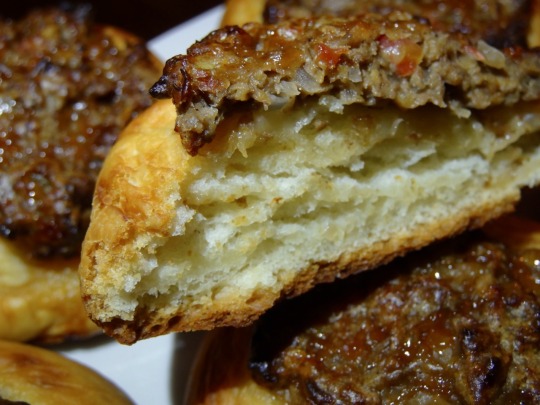
[ID: First image is a close-up on a plate of small flatbreads topped with ground ‘meat’; second is a cross-section of one of the breads. End ID]
صفيحة فلسطينية / Safiha falastinia (Palestinian topped flatbread)
Etymology and origins
صَفِيحَة (“ṣafīḥa”), also transliterated “sfiha” and “sfeeha,” is a flatbread eaten in Palestine, Lebanon, and Syria, comprising a yeasted dough topped with a filling made from ground lamb or beef, spices, and chopped aromatics and vegetables. It may also be called “اللَحْم بالعَجِين” (“al-laḥm b al-‘ajīn,” “meat with dough”)—this phrase is the source of the Turkish “lahmacun” and the Armenian “Լահմաջո” (“lahmadjo”), which describe a closely related dish.
The word “صَفِيحَة” literally means “thin plate” or “sheet”; it comes from the root ص ف ح (ṣ f ḥ), which produces words related to flatness. Compare for example “صَفَّحَ” (“ṣaffaḥa”) “to flatten,” “صَفْحَة” (“ṣafḥa”) “page,” and “صَافَحَ” (“ṣāfaḥa”) “to shake hands.” This term has been borrowed into Brazilian Portuguese as "esfirra" or "esfiha," when the flatbread was brought to Brazil by Levantine immigrants—mostly Christians—beginning in the 1890s. Today, esfiha has been naturalized as a "'typical' Brazilian bar food"; it is said that the typical resident of São Paulo is a "Japanese who speaks Portuguese with an Italian accent while eating an esfiha."
In English, lahmacun (also transliterated "lahmajoun") is sometimes called "Armenian pizza." Similarly, it may be called "صفيحة الأرمنية" ("safiha al-'armaniyya"), "Armenian safiha," in Palestine, indicating that it is regarded as a borrowing from the local Armenian immigrant community. In Armenia, lahmadjo is a very thin, soft flatbread typically topped with beef or lamb, tomatoes, tomato paste, bell peppers, onion, garlic, parsley, red chili paste, and black pepper. With Palestinian safiha, lamb is the typical choice of meat; the dough may be thicker, and enriched with the addition of milk, milk powder, or yoghurt; bell peppers are ommitted; and fried pine nuts may be added. Palestinian restaurateur Nassar Odeh remembers lahmadjo being served in Jerusalem's Old City decades ago; he says that "Armenian dishes" such as this have become "part of the Palestinian culture."
Though the Arabic-derived "lahmadjo" and related terms may be heard, [1] the most common Armenian-language name for this dish is "լոշմիս" ("loshmis")—presumably from "լոշ" "losh" "lavash, thin bread" + "միս" "mis" "meat." Some Western Armenian variations on the name reverse this order (meat-dough, rather than dough-meat): "մսաշոթ" ("msashot"), from "մսա" "msa" "meat" + "շոթ" "shot" "thin bread"; and "մսալոշ" ("msalosh"), from "մսա" "msa" "meat" + "լոշ" "losh" "thin bread."
The dish
A common part of everyday Palestinian cooking, صَفَائِح ("ṣafā'iḥ"; plural of "ṣafīḥa") are often eaten as a snack or a portable lunch. They may also be served as a مَزَّة ("mazza"; "appetizer") for عِيد ("'īd"; "feast," "holiday"; often transliterated "Eid") or Christmas.
Safa'ih are shaped into pinwheels in the port city of يَافَا ("Yāfā"; often transliterated "Yaffa" or "Jaffa"), stuffed with ground meat or spinach. In the Bethlehem region the topping is often mixed with tahina, as well as vinegar or lemon juice, and perhaps pomegranate molasses. Other versions of the meat topping omit tahina and vinegar, and are more tomato-heavy instead.
This recipe is for Bethlehem mazza-style safa'ih, with thick crust that's crisp on the outside and light and fluffy on the inside. Vinegar and pomegranate molasses provide a bright, slightly fruity lift to the topping, while tahina grounds it with a toasty, nutty aroma. Black pepper, allspice, and a green chili pepper add complexity and heat.
[1] There is a proliferation of possible spellings for "lahmadjo" in Armenian, which would indicate that it is a loanword (probably via Turkish, ultimately from Arabic). These spellings include "լամաջո" ("lamadjo") [common]; "լահմաջո" ("lahmadjo"); "լահմաջու" ("lahmadjou"); "լահմաջոն" ("lahmadjon"); "լահմաջուն" ("lahmadjoun") [literary; uncommon]; "լահմաջին" ("lahmadjīn"); and "լահմաջի" ("lahmadjī") [rare]. The letter "ջ" is pronounced as "dj" (IPA: [d͡ʒ]) in Eastern Armenian and a "tch" (IPA: [t͡ʃʰ]) in Western Armenian (timestamp: 40:33).
Support Palestinian resistance by donating to Palestine Action’s bail fund; buying an e-sim for distribution in Gaza; or donating to help a family leave Gaza.
Ingredients:
Makes 24 small safa'ih. Serves 24 as an appetizer, or 6-7 as a main dish.
For the dough:
5 cups (600g) white flour
1 cup (230g) non-dairy yoghurt (لبن رائب) (I used soy)
1/2 cup (125 ml) olive oil
1 1/2 Tbsp (15g) dry yeast
1/2 Tbsp (4g) kosher salt
1 tsp (5g) sugar
A scant cup (220g) of water
A more "everyday" preparation of this dish might make larger, flatter safa'ih out of a dough without dairy. This holiday variant includes yoghurt and makes smaller, fluffier safa'ih; but the yoghurt may be omitted (or milk or milk powder may be added) without injury, and the flatbreads can be made any shape you like.
Leila al-Haddad writes that, in Gaza, white flour used to be eaten as a treat and for special occasions before it later came to replace whole wheat white flour in many kitchens.
For the topping:
500g ground beef substitute (as a replacement for minced lamb)
1 medium tomato, minced
1 medium onion, minced
1-2 green chili peppers, minced
2 tsp kosher salt (1 tsp table salt)
3/4 tsp black pepper
3/4 tsp allspice; or Palestinian 7-spice / mixed spices (بهار مشكل)
1/4 cup white tahina
2 Tbsp pomegranate molasses
2 Tbsp white vinegar, or lemon juice
For a tomato filling, omit the tahina and vinegar, and instead use 2 Tbsp tomato paste; or 8 diced or puréed tomatoes, cooked down.
Instructions:
For the dough:
1. Combine all dry ingredients in a large mixing bowl.
2. Make a well in the center and add in the yoghurt, olive oil, and water. Mix them together and then combine them with the rest of the dough. Add water or flour as needed to obtain a soft, slightly tacky dough.
3. Knead the dough on a clean surface for 5-10 minutes, until it bounces back when pressed. Allow to rise, covered, in an oiled bowl for 1-2 hours, until doubled in size.

For the filling:
1. Mince vegetables, or run them through a food processor. Mix all filling ingredients together.
To assemble:
1. Divide dough in half, and then half again; roll out each quarter of the dough into a cylinder and cut it into six equal pieces.
2. Roll each piece of dough into a ball between your hands, and then flatten it into a disc about 1” (2 1/2 cm) high and 3” (8cm) wide. Place on a baking sheet prepared with parchment paper, leaving an inch of space between each circle.
3. Press the center of each dough circle down to create a crust around the edge. Add a few spoonfuls of filling to the center of each safiha and press flat.

4. Bake safa'ih in the middle of an oven at 450 °F (230 °F) for 25-30 minutes, until crust is golden brown.
Serve as an appetizer alongside vegetable salads, pickles, olives, &c.

436 notes
·
View notes
Text

Rovinj, Croatia: Rovinj is a city in Croatia situated on the north Adriatic Sea. Located on the western coast of the Istrian peninsula, it is a popular tourist resort and an active fishing port. Istriot, a Romance language once widely spoken in this part of Istria, is still spoken by some of the residents. The town is officially bilingual, Croatian and Italian, hence both town names are official and equal. Wikipedia
147 notes
·
View notes
Text
7x03 analysis part 1 — Everything Air Ops
I promised helicopters, so now we get helicopters. I want to look into how Air Operations work in the 9-1-1 universe, in comparison to its real life counterpart in this first part. Then, I will try to figure out the location and intensity of "hurricane Ethel" during the clandestine operation in the second part. And finally, I will prove how risky it is to fly a helicopter into a storm and why Tommy deserves every bit of his Medal of Valor.
Location
Real!LAFD Air Ops operate (Station 114) out of Van Nuys Airport (VNY/KVNY). It's not only one the busiest general aviation airports in the world, it's also smack dab in between major green areas of the city of LA itself.

This location makes perfect sense in real life. Air Ops might get the occasional highway car wreck or urban structural fire calls, but most of their missions still consist of wildfire suppression and rural search and rescue. Being based at Van Nuys makes sure they can respond to emergency in a timely fashion.
in the 9-1-1 universe, the LAFD Air Ops are based at "Harbor Station", or Station 217. (Harbor and 217 are the same station, Chimney especially asked if Tommy was still at the 217 in 2x14 when requesting air support, unless the 911-verse LAFD has 2 different air operation units, which I highly doubt.) Obviously it has to be at an airport, because that's where the hangers and helipads are, and going by "harbor" I can only speculate that it's in the Harbor Region of LA.
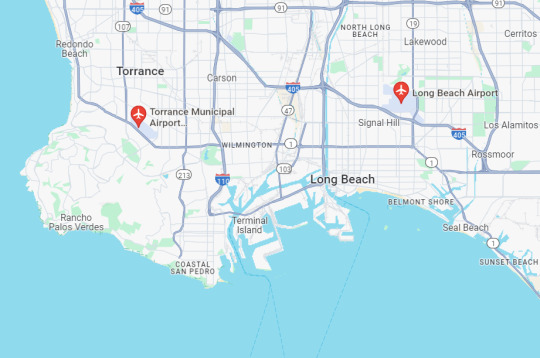
The only non-military airport in the LA Harbor Region is Long Beach Airport (LGB/KLGB), but it's quite a busy commercial airport, probably not a good one to run emergency services from. There's also the Zamperini Field (TOA/KTOA) nearby in Torrance, although not exactly inside the Harbor Region, it's coastal and close enough to the 2 LA ports I guess? Feel free to create a whole new airport using your imagination though, as you know 9-1-1 is set in an alternate universe where geography and physics work differently.
Helicopters
The LAFD Air Ops have 5 medium (FIRE 1-5) and 2 light duty (FIRE 6/7) helicopters, you've heard Tommy in 7x04. Everything applies to the real world counterpart, but the medium type that real!Air Ops operate is AgustaWestland AW139, the Italian-made medium sized twin-engine helicopter with a 5-blade main rotor primed for emergency response and off-shore oil rig transportation.

It has auto-pilot, an anti-icing system for harsh weather and even auto-hover suitable for hoist rescue missions. In a passenger transport configuration, it can carry up to 15 passengers in a 3 row seating plan. In an SAR (search and rescue) configuration though, the middle row can be removed for gurney space. It's big and powerful enough to transport multiple patients, but at the same time, light and agile enough to get into difficult terrain.
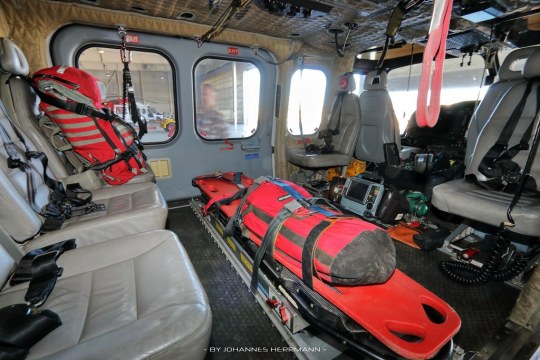
The AW139 is designed to be flown by 2 pilots, flying solo is also possible, but only under VFR (Visual Flight Rules), with an additional certification, which LAFD pilots can and do. To fly it under IFR (Instrument Flight Rules), it always requires 2 pilots according to the FAA last time I checked.
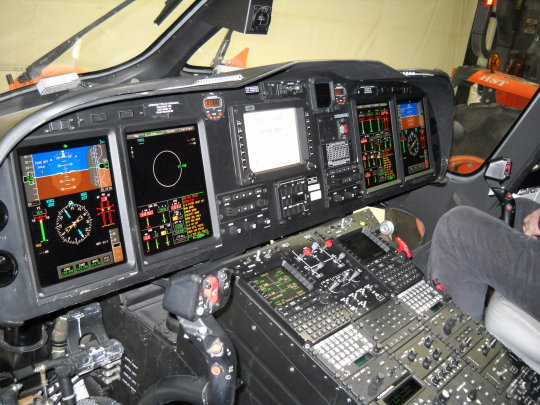
The light helicopter type real!LAFD flies is the Bell 505 Jet Ranger X, a single engine twin-blade made in Canada. It's an relatively new airframe, set to replace the aging Bell 206, which the LAFD used to operate. It's quite a bit smaller than the AW139, it can only fit 1 pilot and 4 passengers.
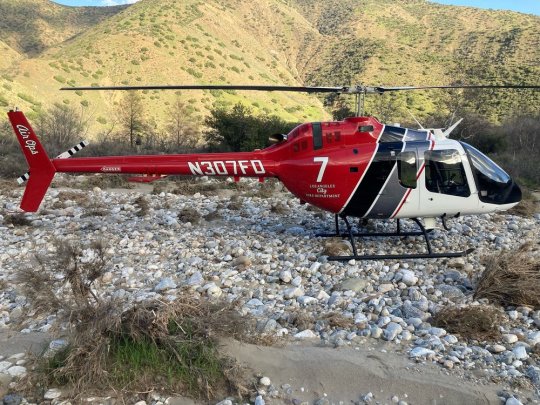
While it's perfectly capable of carrying a Bambi bucket to assist with aerial firefighting missions, it's mainly used as a training aircraft for new pilots and HLCO (Helicopter Coordinator) when there is a major catastrophe that requires on-the-site air traffic coordination.
These are all brand new and sophisticated aircrafts that a mere TV channel can't get their hands on without a government budget. So for 911!LAFD Air Ops, ABC went to their usual helicopter service company for prop aircrafts.
Helinet Aviation provides all sorts of helicopter services from aerial journalism, medevac, delivery to regular chartering. All the 911!Air Ops scenes in 7x03 and 7x04 are naturally filmed in the Helinet hanger, for convenience's sake, at VNY, just a runway across from real!Air Ops.
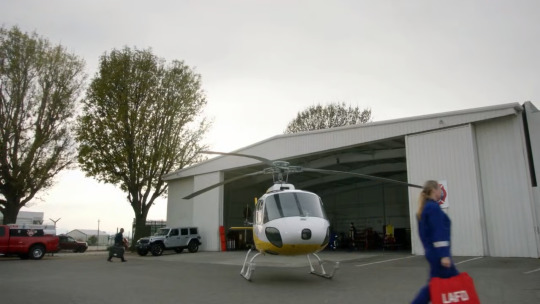
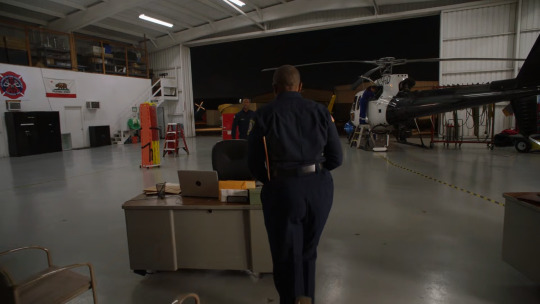
911!Air Ops

Helinet hangar Street View
I believe I've identified all the helicopters shown in 7x03 and 7x04, but let's get the 2 in the background which probably do not belong to 911!Air Ops out of the way:
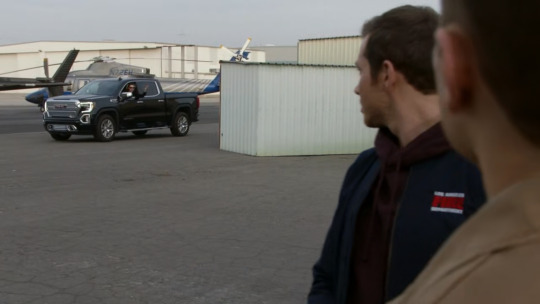
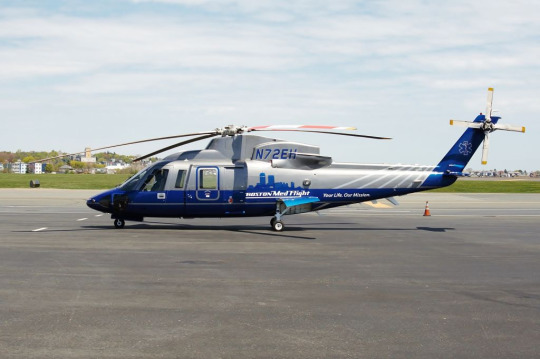
N72EH, a Sikorsky S76C++, still in its Boston MedFlight livery. Sold to Helinet in 2022, possible used as a medevac vehicle currently? Unlikely to have anything to do with 911!Air Ops, probably just happened to be in the background to make it seem like there were many helicopters.

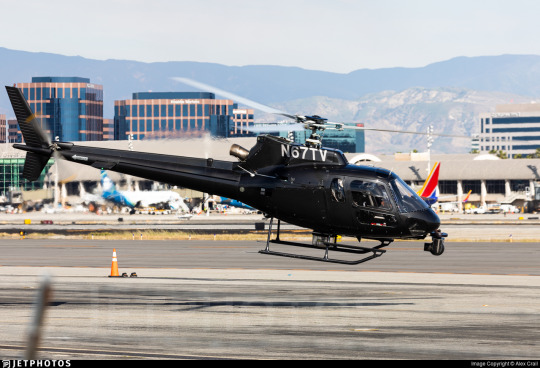
The one Tommy flies Eddit to Vegas in is N67TV, an Eurocopter AS350B2 Écureuil (aka squirrel). No fire department would ever let employees take their expensive equipment out for a joy ride so it's likely that in universe, Tommy rented it from somewhere outside of the station. IRL though, according to this forum post, it's used as a backup helicopter for all its customer news stations, but also any TV or film production purposes outside of journalism.
Now, for the one seen in the hangar, therefore explicitly belonging to 911!LAFD:

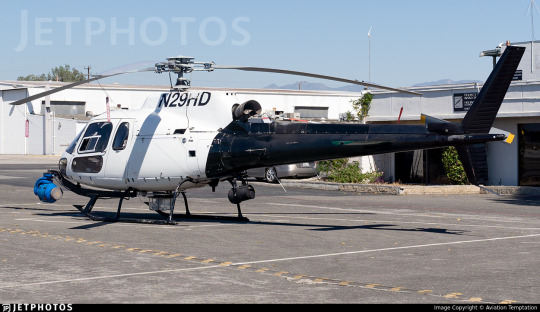
N29HD, also an AS350B2, also a news helicopter. According to this reddit comment, it used to be shared between CBS and FOX, but now it seems to be configured as a dedicated aircraft for ABC7.
The one the who cares gang stole to rescue Bobby and Athena though has a fake registration number on it:
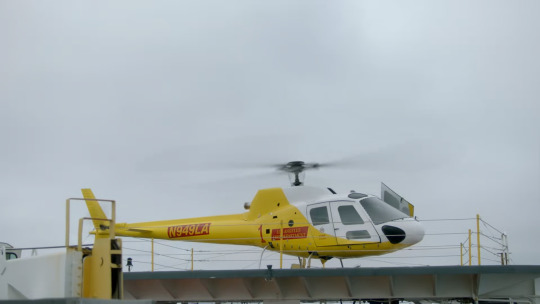
You just have to look up Helinet's fleet, and you will see this is obviously a DHL livery, and it's quite easy to find out that this is actually:

N211FN, an AS350B1 (so an even older variant than the previous two), operated on behalf of DHL for package delivery service.
Don't get me wrong, the AStar (how the AS350 is called in the US) is a versatile and reliable aircraft. It the 4th most produced rotorcraft in the world, someone even managed to land one on top of Mount Everest. But it's kind of small? It can seat only up to 5 passengers with 1 pilot, and there is hardly room left for any gear. There is also no space for stretcher, so anyone they rescue would have to sit upright. It's just not very realistic.
I have no idea what medium duty helicopters 911!Air Ops operate, we're unlikely to see them in the future. There is this Bell 205 in 4x12 Treasure Hunt, but it clearly says L.A County Rescue on the tail.
youtube
Pilots
Real!Air Ops pilots wear beige flight suits, it's the aeromedics who wear blue, and helitac crews wear orange. I'm not complaining too much though, Tommy looks good in blue. (I think the chief pilot wears dark blue, but I'm not sure.)
Helicopter pilots in general usually wear helmets, in case a particularly strong pocket of turbulence slams you against the body of the aircraft, or a bird decide to fly through the windshield into your face, but I get that it gets in the way of the camera, so I'm just gonna enjoy Tommy's beautiful face.
Real!Air Ops pilots work on a 24/48 shift schedule just like any platoon firefighters. Due to the danger of pilot fatigue on aviation safety, they do try to limit their continuous flight time to 6 hours before taking a prolong break.
There are 5 levels of pilots: pilot I (trainee), pilot II (probational), pilot III (full pilot), pilot IV (lead pilot) and pilot V (chief pilot). The chief pilot oversees the entire Air Ops and work on a 10 hour per day, 4 days a week schedule. The rest of the pilots are put into 3 shifts, each shift with a pilot IV, 2 pilot IIIs and 2 trainees/probies, together with 4 aeromedics. (Can't find the most updated version, the lastest one I can get my hands on is from 2022, so good enough?) Therefore Tommy's Bobby would not be a captain, it would be a lead pilot.
I've already explained in detail the timeline of Tommy's career as a firefighting pilot, but here is the short version of it:
Once accepted into the LAFD pilot training program, he would have to train with the LAPD for 180 hours then back to the LAFD for 200 hours, that takes around 2 years, and by then he would be a probie. After that, he would have to slowly build up flight hours then train and certify for all types of missions on the medium duty helicopter, that would take another 2-3 years, and after that he would be promoted to a pilot III, which is probably the rank he holds now.
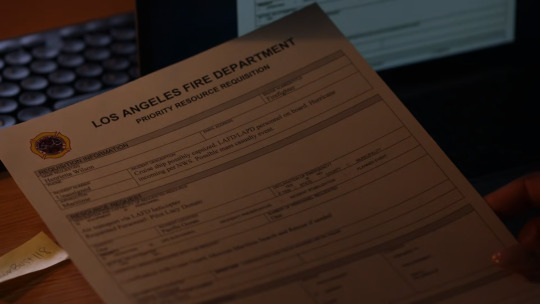
We can see from the form Hen submitted in 7x03 that she initially asked for Lucy as their pilot, as she's forgotten that Tommy also worked there. Fortunately Chimney called Tommy, as Lucy most likely would've still been a probie if not just a trainee.
Melton
I have no idea who he is.
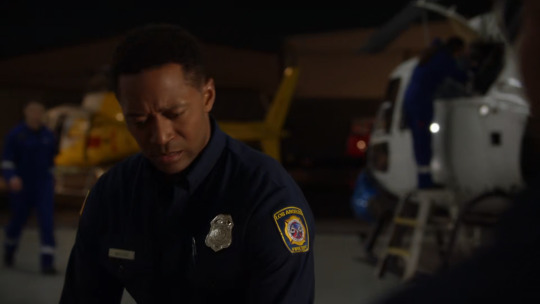
I can sort of see his badge says "firefighter"? At real!Air Ops, everyone wears a flight suit as uniform, so that they can hop into a chopper in an emergency. I don't know what a dude in a regular uniform with the regular LAFD patch on his arm doing there.

Tommy's arm has the Air Ops helicopter patch on it.
Real!Station 114 though do have a crash unit staffed with regular firefighters, maybe Melton is with them? But then, why is he doing with Hen's helicopter requisition?
#911 abc#911 on abc#911 show#911 meta#tommy kinard#tagging the ship for fic writing reasons#bucktommy#tevan#kinley
107 notes
·
View notes
Text





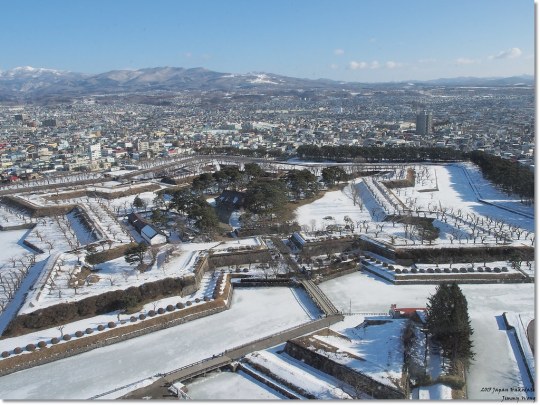

Capitulo 1:ヨーロッパの雰囲気が漂う五稜郭/Goryokaku a hallmark with European airs.
-
Sean bienvenidos a una nueva entrega de cultura e historia japonesa, en este caso vamos a hablar sobre Goryokaku, localizado en Hakodate en la prefectura de Hokkaido al norte de la isla de Honshu.
-
Toponimia de Hokkaido en, el siglo XIX se llamaba Ezo, último reducto del shogunato contra el nuevo orden creando una república (1868-1869). Hay que destacar que Japón estubo cerrado al mundo durante 260 (1603-1868), este periodo se le conoce como periodo Edo, bajo el régimen militar Tokugawa.
-
En 1854 finalizaron los tratados de amistad con Estados Unidos, Gran Bretaña, Rusia. Hakodate se convirtió en una ciudad portuaria abierta al mundo exterior y en 1858, concluyendo el tratado comercial y al año siguiente se convirtió en puerto comercial. Hisaburo Takeda, estudio en Europa y se formó en fortalezas tipo estrelladas de traza italiana, en 1864 se completaron las contribuciones de la fortaleza.
-
Espero que os guste y nos vemos em próximas publicaciones.
-
Welcome to a new installment of Japanese culture and history, in this case we are going to talk about Goryokaku, located in Hakodate in the Hokkaido prefecture north of the island of Honshu.
-
Toponymy of Hokkaido in the 19th century was called Ezo, the last stronghold of the shogunate against the new order creating a republic (1868-1869). It should be noted that Japan was closed to the world for 260 years (1603-1868), this period is known as the Edo period, under the Tokugawa military regime.
-
In 1854 the friendship treaties with the United States, Great Britain, and Russia ended. Hakodate became a port city open to the outside world and in 1858, concluding the commercial treaty and the following year it became a commercial port. Hisaburo Takeda, studied in Europe and trained in Italian star-type fortresses, in 1864 the contributions of the fortress were completed.
-
日本の文化と歴史の新しい記事へようこそ。今回は、本州の北、北海道の函館にある五稜郭について話します。
-
19 世紀の北海道の地名は蝦夷と呼ばれ、共和制を樹立する新秩序(1868~1869 年)に対抗する幕府の最後の拠点でした。 日本は 260 年間 (1603 年から 1868 年まで) 鎖国していたことに注意してください。この期間は、徳川軍事政権下の江戸時代として知られています。
-
1854 年にアメリカ、イギリス、ロシアとの友好条約が終了しました。 函館は対外に開かれた港湾都市となり、1858年に通商条約を締結し、翌年には商業港となりました。 武田久三郎はヨーロッパに留学し、イタリアの星型要塞で訓練を受け、1864 年に要塞の建設を完了しました。
source/ソース:photos internet/写真インターネット
#japan#history#architecture#Hakodate#Hokkaido#republic#unesco#fortitude#geography#perdioedo#Erameiji#archaeology#Goryokaku#日本#歴史#建築#函館#北海道#共和国#ユネスコ#慰霊#地理#永明寺#考古学#五稜郭#Photography#写真#photographers on tumblr#artists on tumblr
288 notes
·
View notes
Text
Scherzo (a Barón Tovar Takes a Wife one-shot)
3.1K / Bridgerton AU Regency!Pero Tovar x fem!reader
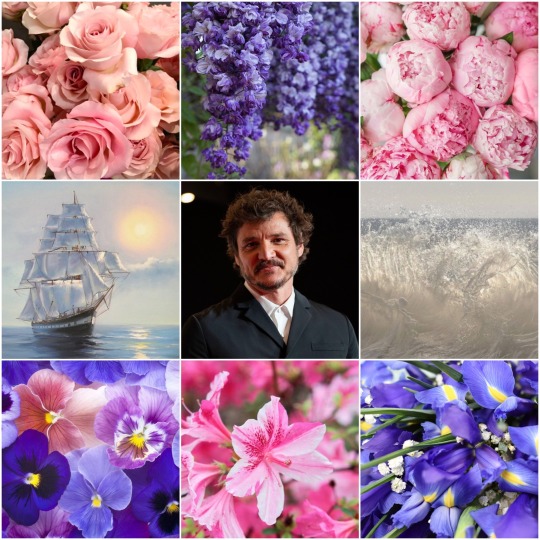
Scherzo - a short composition – sometimes a movement from a larger work such as a symphony or a sonata
Summary: Your husband takes care of you when you get hurt during your travels.
Warnings: None! All fluff, though reader gets cheeky with her husband cause I mean, it's Pero? Protective!Pero, Soft Husband!Pero (I NEED HIM). A little bit of violence is described where reader gets physically hurt, nothing graphic.
A/N: This was written for @morallyinept's Flora & Fauna challenge; please see #jettsflora&faunachallenge for all the other amazing works by some wonderful authors (I didn't do much with the meanings of the flowers, was just going for ✨vibes✨ - hope it's okay!). I tend to always miss my babies after I complete their series, and can't help but write little one-shots for them to see what they're up to. This is our Regency couple from Barón Tovar Takes a Wife, but you don't need to read it (although it would be cool if you did - I'm kind of proud of this one 😭) - just know our happy Barón and Baronesa are doing what they love the most, which is travelling on the high seas together.
Beautiful Bridgerton inspired dividers by @saradika-graphics 🥰

Truth be told, Naples is not one of Pero’s favourite places to visit in Italy; the Barón much preferred the rolling vineyards of Tuscany or the cultural diversity of Milan. At least it will be a short stay, too short to even arrange for lodging in the city; it was much easier for everyone on the ship to remain staying in their onboard quarters while he oversaw some Royal fleet business with the Italians. It would be just three short weeks before they're set to raise the sails again, this time charting a course up the western Italian coast to the Civitavecchia Port of Rome. He realizes the last time the two of you were in Rome had been when you said your final goodbyes in his youth, parting ways and not meeting again for over ten years; Pero looks forward to strolling the cobblestone streets together once more, this time with you as his bride.
In the meantime, he would try to expedite the matter before him – if the Italian dignitary sitting across from him would acquiesce, perhaps he can still save enough of the day to take you to do some sightseeing before nightfall. Just as the stout man’s mustache twitches at something he’s read on the document Pero gave him, someone bursts into the office, violently banging open the door.
Recognizing one of his trusted footmen, Pero exclaims, “Miguel, could this wait? Signor Romano and I are in the middle of something.”
“No!” cries Miguel, alarmingly, “My apologies, Barón! It is the Baronesa...”
Pero reacts with blinding speed, his chair knocked to the ground from the force with which he stands, “What has happened?!”
“There was a commotion in the square, my lord. Your wife was hur-”
Pero is already out the door, running as fast as he can towards the city square where he knows you and your lady's maid, Lucia, had planned to do some exploring while he was away at meetings. Wind rushing past his ears, he can hear behind him the faint thundering footsteps of Miguel the footman trying to keep up with his master.
When he gets to the square, Pero is stunned to find it in a mild state of chaos – several shops have been vandalized and an overwhelming number people seem to be in a state of mild panic, crying. He scans the crowd and when he finally spots you, he nearly falls to his knees. You’re sitting on the ground next to Lucia who is crying loudly, comforting her the best you can; and while Lucia is clearly emotionally distraught, she appears to be physically unharmed - the same cannot be said for you. Your dress is torn in several places and covered in blood; whose blood Pero does not know, but he realizes, stomach dropping, that some of it at least must be yours when he sees the long bleeding cut down your left forearm. Your beautiful face has at least one messy scrape across your cheek that he can see even at this distance and your lip looks like it’s starting to discolour and swell.
You spot Pero when he is a but few steps away and instantly feel a wave of relief wash over you at the sight of your strong, handsome husband (though you do hate to see the look of panic and terror on his face). Dropping down to your side, Pero immediately cups your face in his warm, bear paw hands, careful not to disturb any of your injuries, “Dulce! How are you?”
You don’t want to tell Pero that your heart is still beating fast from how scared you had felt during the stampede, or how the cuts on your arm and face sting and that your sides and back have started to ache. You know that doing so will only make him feel worse - but you’ve never lied to your husband in all the years you’ve known him so you simply say, truthfully, “Better now that you’re here, Pero.” Melting into the soft tender kiss he presses to your mouth, you try not wince when his soft lips meet your bruised ones but fail miserably. Trying not to shatter in front of you when he hears your pained whimper, Pero wills himself to pull back with a silent reminder to handle you with more care; as he starts to check over your injuries, he asks delicately, “What happened, mi amor?”
One of the sailors who had joined the footmen in accompanying you and Lucia starts to explain before he’s silenced by a glowering look from your husband; Baronesa Tovar is not a woman who needs others to speak for her.
You give the poor sailor a reassuring smile before drawing Pero’s attention back to you and recount for him what happened in the square earlier. Noticing that the Barón's hands have been cold in the mornings as of late, you had headed out today with a mission to purchase your husband some gloves made with the fine leather craftsmanship that the Italians are known for. While admiring the buttery softness of a pair of large leather gloves handed to you by a lovely stall merchant, a fight had broken out across the square between a mob of over twenty large and angry Italian men. The fighting horde continued their bout while moving across the square, barreling into families and unsuspecting people just trying to go about their day. Caught unawares, the pedestrians scattered and ran panicked in an effort to get out the way of the oncoming melee. The fleeing crowd had ran in your direction and you and Lucia could not get out of the way fast enough – pushed down to the ground, in your attempt to shield Lucia as the two of you tried to crawl to the side of the street and away from the mob, your dress had been torn by the flurry of feet as runners stampeded, your body kicked more than once. At one point, someone had produced a pistol and shot at several buildings; and while that effectively ended the fight, several windows had shattered and some of the errant glass had fallen and cut your arm.
Pero feels absolutely sick at the picture his mind conjures of you being physically pushed and kicked, imagining how scared you must have been; he wants nothing more than to sweep you into his arms and comfort you, but without knowing the extent of your injuries, he settles for pressing his forehead to yours and whispering that everything will be okay now. You believe him.
With some difficulty, Pero helps you stand and brings you back to the ship; both of you agreeing that when the doctor is called, it should be to the safety and comfort of your own quarters. Though ever gentle with you, the fearsome scowl on Pero’s face clears a path from the square down to the docks – the deep furrow of his brow accentuating the faded scar over his left eye, as if to challenge anyone who would get between his wife and her safe haven. Calling out for medical supplies and hot water as soon as he’s onboard, Pero leads you to your chambers and sits you on your shared bed before falling to his knees in front of you. Slumping, tension in his strong frame finally dissolving, Pero lays his head in your lap and lets a few tears fall at the relief of finally getting you back home, safe. You stroke your husband’s soft curls lovingly, understanding all of him and letting his devotion wash over you - it brings you a calm that you haven’t felt for several hours now.
In silence, you let Pero tend to your cuts and scrapes, eyes never leaving his handsome face as you watch him concentrate on being gentle with his big, sometimes clumsy hands. Pero washes your face and hands, wiping away all evidence of the time you spent on the hard stone streets of the square, then takes care to thoroughly clean your injuries. When you hiss at the sting from the salve he applies to the cut on your arm, Pero murmurs, “Be good for me, Baronesa,” and distracts you momentarily from the pain with that sweet smile of his that he knows makes you melt.
Finally comes the point that Pero has been dreading; he undresses you carefully to tend to the injuries on your body, hoping none will be too serious. Once he has you stripped to the barest of your undergarments, he takes in the bruising that’s starting to show on your legs, hips and back and thinks he might cry again; his beautiful wife, so brave and strong – he cannot believe you sustained these injuries and still allowed him to move you about as he has without complaint. As if reading his mind, you run a finger through your husband’s scruff that you love so much and try to lighten his mood; nodding towards your discarded dress on the floor, you joke, “I do not think I will be wearing that dress again.”
Half serious, Pero replies, “I think I will bring it to the Polizia tomorrow, when I demand answers for how they allowed what happened in the square to transpire.”
“Pero.”
“Or we throw it over the side of the ship,” he shrugs, a little bit a light returning back to his eyes when he sees your good humour is unscathed; permitting himself to hold you close, Pero breathes his first calm breath since Miguel interrupted his meeting, inhaling your soft perfume. Seeing Pero in a better mood instantly lifts your spirits, and while in the safety of his loving arms, you give him a playful little wiggle and press your barely clad body to his.
“Dulce,” he warns, voice dipping low at your giggles. To show him it’s just a little bit of teasing, you straighten up immediately and allow Pero to run the warm cloth over your body and finish cleaning you up before dressing in your most modest nightgown without any more shenanigans.
The doctor who is called leaves a short while later, declaring that both you and Lucia will be fine and that a few weeks of lightened activity and rest should heal your injuries without issue. It’s not something you’re looking forward to, but you agree with Pero that for the remainder of your time in Naples, it would be better if you recovered from the safety of the ship.

For the first few days, you enjoy the calm and quiet of your vessel, many of the sailors and staff taking the opportunity to enjoy some leave while docked. But as the days go on, with Pero away for most of the day on business, you find yourself getting restless. You read your books and write your letters. You play your piano and even entreat Lucia and whomever remains onboard to play cards with you. From the ship’s deck you can still see much of the city, and even though you have no particular wish to return on this trip (your experience in the square still too fresh), it unfairly beckons to you like a siren. You’re bored. And despite loving your ship, you’re starting to feel cooped up.
Pero does his best each day to finish up his work as quickly as possible so he can return to you, enjoying the warmth of your company and checking for himself that you’re recovering properly. The Barón brings home delicious treats and pretty trinkets for his wife everyday, leaving no doubt that you’re ever on his mind even when apart. And while you love your husband dearly for his thoughtfulness, you cannot help, while enjoying his gifts from within the boundaries of a ship that once represented freedom to you, feeling a bit envious at being unable to go out and procure them for yourself. Pero can tell that you’re feeling a bit out of sorts, not your usual cheerful self; he so hates to see the wings of his pretty dove clipped – it saddens him just as much to see you try to hide your melancholy from him. And although he cannot agree to lift the current restrictions on your movements, he deeply wishes for a way to make your so-called confinement as pleasant as possible.
The morning that marks the start of your last week in Naples, you wake to an absolute ruckus coming from the ship deck; for a moment you feel a stab of fear, unused to such loud noises and voices without having been given some forewarning. You must still be feeling some effects of your recent scare, you think; upon listening a bit more carefully, you relax to the realization that the voices are primarily instructive and even calm. But it’s still much too early for this level of activity from the deck – the footsteps and voices you hear must be from at least double the amount of people you would normally expect to be up at this time of day. Also unusual is that you’ve woken up to an empty bed; every day following the incident in the square, you’ve woken up to your husband curled around you, arms and legs thrown over your body like protective amour. You don’t think you particularly like today’s change, but it makes sense – you can’t imagine whatever is going on outside to be taking place without your Pero’s permission. Not especially looking forward to another day of doing the same things again within the same confines of the ship, you lay in bed for a while longer, at least until the noises start to die down and your curiosity gets the better of you.
The sight that greets you as you open the door to the deck nearly knocks you off your feet. Somehow, it’s not a wooden ship’s deck that you’re now gazing upon, but a colourful and enchantingly idyllic scene, something that could have been painted by a great master of the arts. For a moment, you have to pinch yourself, is this a dream?
You step through the doorway from the ship’s hold into an ethereal garden – blooming flowers have overtaken every inch of the ship’s deck: thick braided garlands of roses, violets, and peonies wrap wondrously around every one of the ship’s railings, big bright pots of lilacs, azaleas and irises line the sides of the ship and surround a makeshift sitting area where some garden furniture you’ve never seen before has been arranged. Even the mast has been decorated to look like a spring maypole, intertwining vines of clematis and jasmine crisscross all the way down from the crow’s nest so tightly you can barely see any of the dark wood that normally centres your great vessel. Every bow is positively dripping with wisterias, reminding you for a moment of your beloved Bridgerton House. You walk slowly through the dreamlike scene, weaving between the lush plants and the fresh, bold flowers. Brushing your hand over the railing as you meander, your fingertips flutter at the soft feel of the blooming petals and your eyes brighten at the rainbow hues that paint every perimeter inch of the ship. Your nose breathes in the sweet and intoxicating floral scent that now dances lightly in the air. You close your eyes and inhale. Your eyes open again with a soft exhale. Repeat.
You’re turning around slowly, trying to take in the entirety of your magical surroundings when your eyes land on your beaming husband, standing like a handsome faerie king holding an exquisite bouquet of your favourite peonies in his hand, waiting for his pretty queen to take in all his hard work. Despite the residual pain you still feel a bit in your sides, you launch yourself into Pero’s arms, throwing your own around his neck and passionately press your lips to his. Mouth opening, you let Pero lick in and explore, before pulling yourself up onto your toes and suck on his tongue eagerly. Pero pulls you in tightly and when he feels your tongue stroke behind his teeth, lets loose a deep vibrating hum of want that reverberates through you, straight to your core. With a quick nibble to your bottom lip and a few chasing flutter kisses, Pero reluctantly pulls away; he’s sure there are curious eyes all over the ship deck, even if they are currently concealed by the splendid greenery that’s overtaken the space.
When he steps back look at you, the expression on your face almost gives Pero enough reason to throw modesty and decorum out the window, grab at your enticing curves and throw you down amidst the lush fauna he’s brought onto the ship to have his way with you. Almost. Your eyes shine bright and twinkle, there’s a fresh glow to your cheeks, and your smile is the widest that he’s seen in weeks: you’re alive again.
“Pero,” you cry in bliss, “what is all this?”
The Barón gently cradles your head in his hand and reverently strokes the soft hair of his beloved Baronesa, “Mi amor, I could tell that staying confined to the ship has not been agreeing with you. If you cannot go out to explore and play in the wide world, then I will do my best to bring the wide world to you. Now, instead of a cold, dreary ship deck, I hope you will enjoy the remainder of the week before we set sail in your own private garden.”
You could cry – what did you ever do to deserve the love and devotion of your perfect husband? He forever thinks of your comfort and the wellness of your heart – but he does so much more than just take care of you or do things that make you happy, he’s the reason for your joy, for your very being. You cannot stop murmuring, Thank you thank you thank you, into his chest as he holds you close, not only to him but for him.

The flowers last a week which is precisely how long you need them to last. During those final days before your fleet sets sail, you find yourself soothed every time you enter or sit in your personal secret garden; second, by the tranquility and peacefulness of your botanical hideaway, and first, by the knowledge that you have the love of the kindest, sweetest man on earth.
Leaning now along the once again bare wood railing, with the salty sea wind blowing through your hair, you feel a pair of strong arms wrap around your waist. The patchy facial hair of your husband tickles your cheek as he presses a sweet kiss to your temple and whispers in your ear, “Happy to be on our way, Dulce?”
Turning in his arms, you snuggle into his safe hold; tucking yourself under his chin, you sigh into Pero’s neck, “Just happy, mi amor.”
#jettsflora&faunachallenge#pero tovar#regency!pero tovar#pero tovar fic#pero tovar fanfiction#bridgerton au#pero tovar series#pero tovar x you#pero tovar x f!reader#pero tovar x reader#pedro pascal characters fanfiction#pedro pascal characters#no y/n
85 notes
·
View notes
Photo

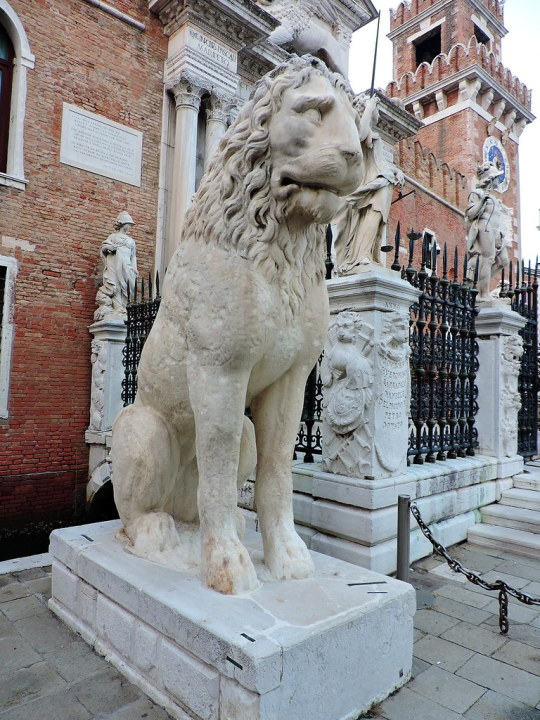
The Parthenon marbles this, the Parthenon marbles that...
I don´t know how known the extent of Greek antiquity looting by West Europeans is to most people or most have a limited image painting the British Museum or Lord Elgin as the sole / main villain.
Here we have the Piraeus Lion (Italian: Leone del Pireo) , one of the four lions decorating the Venetian arsenal in Italy. The prominence of the 3 meter tall lion statue in the port is such that it is also known as Porto Leone ("Lion Port").
We are eternally thankful for the massive courtesy of calling the statue the Piraeus Lion, indicating its origin from Piraeus, the port city of Athens. The statue was sculpted around 360 BC and remained a famous landmark of Piraeus, Athens until 1687.
In 1687, it was looted by Venetian naval commander Francesco Morosini, the man also notoriously responsible for the bombardment of the Parthenon during the wars of the Venetians with the Ottoman Turks, therefore in fact the most irreversible destruction it suffered in its 2,500 year long history. Somehow they were fighting the Turks but it was the Greeks paying for it.
Is it totally and universally acknowledged that Morosini illegally looted this sculpture among so many others? Yes. Does the Piraeus Lion still sit casually in the Venetian port in 2024 as if Venice has a shortage of artefacts to decorate itself with? Also yes. Meanwhile, the Greeks have to limit themselves to a replica in the Piraeus Archaeological Museum.
The Horses of Saint Mark in Venice are also Greek artefacts, this time looted from Constantinople during the crusades, although their original display was in Chios island. Another thing little known is how many ancient and medieval Greek artefacts were looted from the Eastern Roman / Byzantine Empire because people tend to focus on classical antiquities looted in the 19th century.
[Fun fact: The Piraeus Lion has runic inscriptions carved by Swedes in the 11th century. These were either Viking explorers or Varangian mercenaries of the Byzantine Empire.]
#greece#europe#greek culture#ancient greece#western appropriation#crusades#antiquity looting#ancient greek statues#piraeus lion#venice
129 notes
·
View notes
Text

Tango street dancers, La Boca Buenos Aires, Argentina: La Boca is a neighborhood in Buenos Aires historically linked to the Italian city of Genoa. It is located in the southern part of town near the old port. La Boca is famous for its colorful houses made of wood and tin and also for its pedestrian streets. The most famous street is Caminito where there are many souvenir shops and performances of tango dancers.
82 notes
·
View notes
Text
Thinking about the Holocaust in Africa.
Here, European notions of anti-Blackness and antisemitism became intertwined.
There was a fusion between the dispossession and racism of European imperialism and colonization projects of the late nineteenth century, and the prison regimes imposed by European fascism in the early twentieth century.
Scholars Sarah Abrevaya Stein and Aomar Boum have recently written much about the importance of recognizing the trauma of labor and internment camps in North Africa during the second world war.
And I want to express my gratitude for their work. I want to share some of what they’ve written in a couple of recent articles.
In their words: “Nazism in Europe was underlaid by an intricate matrix of racist, eugenicist and nationalist ideas. But the war – and the Holocaust – appears even more complex if historians take into account the racist and violent color wheel that spun in North Africa.” [1]
France's prison camps in North Africa were filled with Algerians, local Jews, deported European Jews, Eastern European refugees, domestic political dissidents from France, people fleeing fascist Spain, Moroccan residents, Senegalese subjects of French rule, other West Africans displaced by French occupation, and more.
The anti-Blackness and antisemitism that had fueled Europe's colonial expansion was finding new expression in fascist Europe.
---
Seems France is a central antagonist in the story of evolving approaches to empire, racism, and resource extraction.
After their 1940 alliance with the Nazis, the Vichy French government maintained technical control of French colonies across Africa. Beginning in 1940, the French government “alone built nearly 70 such camps in the Sahara.” [1] This was in addition to another six labor camps which the French government built in West Africa (in Senegal, Guinea, and Mali).
---
By the beginning of the twentieth century, French-influenced or -controlled territory in North Africa was home to around 500,000 Jews, many of whom had been living in the region for centuries or millennia, speaking many languages, “reflecting their many different cultures and ethnicities: Arabic, French, Tamazight – a Berber language – and Haketia, a form of Judeo-Spanish spoken in northern Morocco.” [1] The Vichy French government officially stripped North African Jews of formal citizenship and seized their assets.
Then, deporting residents of Europe and political dissidents in “early 1941, the Vichy authorities transferred hundreds of Jewish and non-Jewish refugees, including women and children, to the Saharan labor camps.” [2] Under French rule “in Algeria [...], it was estimated that 2,000-3,000 Jews were interned in camps [...] resulting in a total prisoner population of 15,000-20,000.” [2] France pursued an “unrealized dream of the nineteenth century” [2]: the completion of the Mediterranean-Niger railroad line in the Sahara, a transportation route across the vast desert to connect the prosperous West African port of Dakar with the Mediterranean coast of Algeria.
Meanwhile the “Vichy regime [...] continued racist policies begun by France’s Third Republic, which pushed young Black men from the empire into forced military service,” including forced recruitment from “Senegal, French Guinea, Ivory Coast, Niger and Mauritania; [...] Benin, Gambia and Burkina Faso; and Muslim men from Morocco and Algeria. In these ways, the French carried on a wartime campaign of anti-Blackness and Islamophobia, pairing these forms of racialized hatred from the colonial era with antisemitism. Antisemitism had deep roots in French and colonial history, but it found new force in the era of fascism.” [1]
---
In late 1942, during the Nazi occupation of Tunisia, the SS “imprisoned some 5,000 Jewish men in roughly 40 forced labor and detention camps on the front lines and in cities like Tunis.” [2] The fascist Italian government had been experimenting with racist and anti-Black policy in their colonization of East Africa; these policies were expanded in Libya. Here, “Mussolini ordered the Jews of Cyrenaica moved” as “most of the 2,600 Jews deported [...] were sent to the camp of Giado” while “other Libyan Jews were deported to the camps of Buqbuq and Sidi Azaz.” [2]
---
Stein and Boum describe the diversity of prisoner experience: “In these camps, [...] the complex racist logic of Nazism and fascism took vivid form. Muslims arrested for anti-colonial activities were pressed into back-breaking labor” and “broke bread with other forced workers” including ‘Ukrainians, Americans, Germans, Russian Jews and others [...] arrested, deported and imprisoned by the Vichy regime after fleeing Franco’s Spain. There were political enemies of the Vichy and Nazi regime too, including socialists, communists, union members [...] overseen by [...] forcibly recruited [...] Moroccan and Black Senegalese men, who were often little more than prisoners themselves.” [1]
As Stein and Boum describe it: “Vichy North Africa became a unique site [...] where colonialism and fascism co-existed and overlapped.” [2]
They write: “Together, we have spent a decade gathering the voices of the diverse peoples who endured World War II in North Africa, across lines of race, class, language and region. Their letters, diaries, memoirs, poetry and oral histories are both defiant and broken. They express both faith and despair. All in all, they understood themselves to be trapped in a monstrous machine of fascism, occupation, violence and racism.” [1]
---
[1]: Sarah Abrevaya Stein and Aomar Boum. “80 years ago, Nazi Germany occupied Tunisia - but North Africans’ experiences of World War II often go unheard.” The Conversation. 15 November 2022.
[2]: Sarah Arbevaya Stein and Aomar Boum. “Labor and Internment Camps in North Africa.” Holocaust Encyclopedia online. Last edited 13 May 2019.
566 notes
·
View notes
Photo

London Blitz
The London Blitz was the sustained bombing of Britain's capital by the German and Italian air forces from September 1940 to May 1941 during the Second World War (1939-45). The objective was to bomb Britain into submission, but despite almost 100,000 civilians being killed or injured in the nightly raids, Londoners resisted, and the war went on.
Hitler's Objectives
Britain declared war on Germany in September 1939 following the latter's invasion of Poland. By mid-1940, Germany had marched through the Low Countries, British forces had abandoned the Continent in the Dunkirk evacuation, and France had fallen. A German invasion of Britain (Operation Sea Lion) looked imminent, and it would surely be preceded by the Luftwaffe (German Air Force) attacking Britain to gain air superiority. Cities might also be threatened, just as they had been in the First World War (1914-18) when German Zeppelin airships had attacked London.
At first, the Luftwaffe concentrated on trying to destroy the Royal Air Force (RAF) in the air and on the ground by bombing airfields. When this strategy proved unsuccessful, and the RAF effectively won the Battle of Britain, the Luftwaffe changed tactics. Bombing London and other cities became the new objective, as specified in a directive from the leader of Nazi Germany, Adolf Hitler (1889-45): "...for disruptive attacks on the population and air defences of major British cities, including London, by day and night" (quoted in Dear, 108).
The Luftwaffe was now intent on destroying Britain's material supplies and crushing civilian morale by targeting the docks in London's East End, key industrial sites, power stations, railway terminals, and other ports. London was just 30 minutes from Luftwaffe bases and an easy target thanks to the highly visible (even at night) dramatic bends in the River Thames. The strategy, in the end, failed to weaken Britain's resolve, but hundreds of thousands of civilians would first have to live through a nightmare of bombing that lasted nine months with long periods when raids came every single night.
Continue reading...
36 notes
·
View notes
Text
So before I introduce more sims, I thought it'd be useful to give the head canon I have for the main worlds I plan on using. I've also given new made up french names to these worlds, in order to make it less immersion breaking for myself.
And I've made some maps to help me in my explanations since I'm aware not everybody know the areas, cities and towns I'm gonna be referencing.

The first thing to note is that I'll be mostly playing in Windenburg and Newcrest which I've both situated in Normandy, more details on that in a bit. Other worlds I'll be locating in France will be Brindleton and Britechester. I'm on the fence on Tartosia which will either be a french town near Nice or an italian town on the west coast.
Brindleton will be called Loguenan. It will be situated on the north-east coast of Brittany and inspired by Saint-Malo and little coastal towns near it.
Britechester will be called Rormay. In my headcanon this is a city roughly taking Reims's spot on the map but architecturally the influences will be a mix of Reims, Paris, Nancy & Brussels (because I need to channel all my art nouveau inspo somewhere).
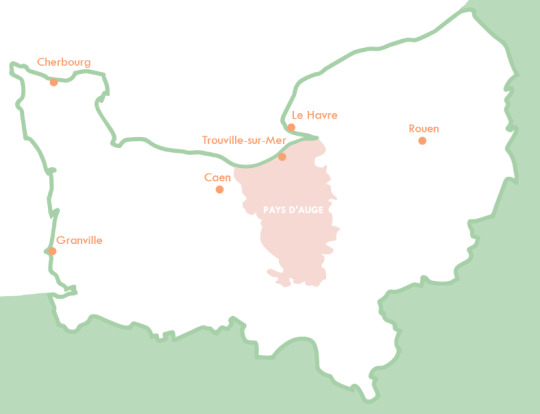
So now about Normandy which will be the main focus of my save (for now at least, who knows, things happen in 140 sims years) : this is a place very close to my heart, where my family is from and where I grew up so I'm very excited to explore its history and architecture.
Newcrest will be called Dorfleur, it's a city that's basically a mix of Caen and Rouen.
Finally Windenburg will be called Honfreville-sur-Mer which I'm placing in the general Pays d'Auge area because it match best the world and its half-timbering imo.

Old Platz becomes Honfreville Centre, the town's city center
For this neighboorhood I'm not really taking inspiration from one specific place just mixing stuff I've seen from various normand towns
Lykke Centre becomes Honfreville Quai, the town's quay/port
For now I won't be playing in this neighboorhood but I have plans for post 1945 builds inspired by places like Le Havre et Cherbourg
Windslar becomes Couligny
In my head canon this in a village near Honfreville-sur-Mer which is slightly more inland. Once again the inspiration is from all over Normandy.
The Crumbling Isle becomes the Île de Préhou
This island will be mostly inspired by places like Trouville-sur-Mer, Granville and more broadly by little coastal fishing towns that turned into seaside resorts over the course of the 19th and 20th century. It's not far off the coast from Honfreville. I'm deliberately choosing not to use actual normand Islands as references for this because this is the only beaches I get in this world and I'll be damned if I don't explore the seaside tourism aspect of the region and eventually cover this place with villas.
Finally, here is a map of all my made up towns and cities :
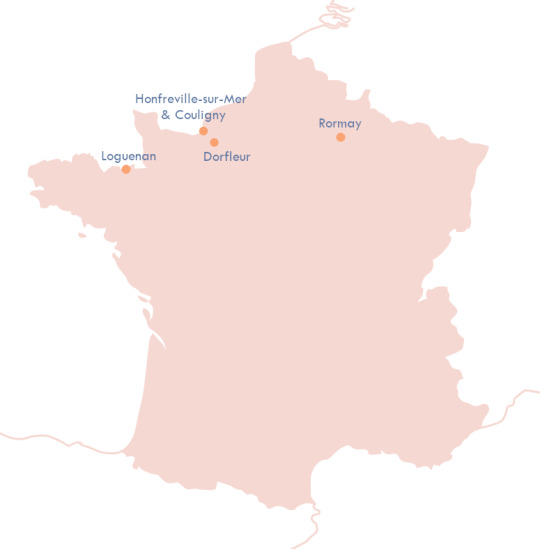
#lore lore lore#Au fil du temps#ts4 historical#worldbuilding#Honfreville-sur-mer#Couligny#île de Préhou#Dorfleur#Loguenan#Rormay#yes I spent a full day making maps for my little made up places 🙃#Alice is from Loguenan and just arrived in Honfreville#Émile lives in Couligny
30 notes
·
View notes
Text
Scott's World of Tomorrow

It was February 1956, a young Scott Heyward had just turned 16 years old. His father, Duster Heyward of Heyward Oil is about to spoil him.
"Well son taday's yer birthday. What do ya wanna do?"
"Can we go to Disneyland Pa? They have a whole section called Tomorrowland and a race car track called Autopia."
Mr. Heyward smiles as he claps Scott's shoulder.
"Tha's mah boy. Disneyland's gonna be a great client ta have. Can't be runnin no rides without oil."
"Yeah and maybe if they have real cars there I can take some notes for the research department."
Mr. Heyward chuckles as he goes to the phone.
"Ah'll just let yer tutor know yer goin on a field trip. That oughta make 'em happy yer doin yer science project."
"Ok, Pa."
Time Skip
"Alright then son. Ah'm gonna be talk with some a Disney's people. They said some fella named Bob Gurr's gonna be walkin ya through Autopia."
"Wow. Thanks Pa!"
Scott sits down on a bench with his camera and notepad. A young man his 20s approaches him.
"Are you Scott Heyward?"
"Yes. Are you Mr. Gurr?"
"That I am. Just call me Bob today. It's really an honor to have you and father come to the park today."
The two shake hands and start to walk to Tomorrowland.
"Now as you can see, the Moonliner was designed by one of my colleagues, John Hench and of course sponsored by Howard Hughes of Trans World Airlines."
Scott takes some pictures as they walk through the attraction. They get to the Monsanto Hall of Chemistry.
"Are you familiar with Monsanto, Scott?"
"Oh yes. I was only 7 when they had that explosion down in Texas City. Pa sent a crew to bring oil down to the site. He managed to get a deal where we can have a couple ships down at the port."
Bob nods. Eventually they make it to Autopia.
"Now this is what I helped design. I used what I learned from working with Ford."
"You worked with Ford? What did you do?"
"Well I helped design the Lincoln Continental. I published a few books on automotive design and that's what brought Mr. Disney's attention over to me. He wanted me to analyze the chassis for these cars. Originally designed by Hartmann Engineering, they were having issues regarding the ability to be mass produced. Too noisy and smokey with a lot of vibration. Eventually the company dropped out so I was brought on permanently to come up with a different design."
Scott's writing all of this down the best he can. Mr. Gurr's slowly turning into an idol.
"So where did you get the design for the cars? They don't look like anything I've ever seen."
"Take a closer look. If you're familiar with Porsche, I took the idea of their 54 550 Spyder and combined it with the recent custom made Italian Ferraris. Of course the Chevrolet Corvette also served as inspiration."
"Wow."
Bob continues telling his story. Scott listens to every word including everything about engineering he has yet to learn.
"What make are these cars now?"
"Currently these are the Mark II's. I had to fix the chassis so they can accommodate a sturdier, smoother-running engine. We've been getting a lot of youngsters so it was necessary to add booster seats and extensions on the peddles. I just finished a prototype for the Mark III and already started work on the Mark IVs"
"Why? What's wrong with these models?"
"Longevity and ease of repair. With how popular this attraction is getting it's only a matter of time before these cars will need repairing. Every month we're learning something new about what people like and don't like about the car. Just goes to show that even when a product is a success, there's still a lot that needs to be done to perfect it."
Scott writes this down as Bob finishes talking.
"Would you like to ride in one of these, Scott?"
"Yes! I'd love to."
Bob chuckles as they wait in line to ride in one of the cars.
Time Skip
"How was yer trip son?"
"I loved it Pa. Mr. Gurr let me take so many pictures and showed me all of Tomorrowland."
Mr. Heyward smiles as they make their way back to Texas. Scott would recite his notes and Bob's story. His father could only nod along as he never really got into the science side of business.
"Well Ah bet yer science project'll turn out real good."
"Oh yeah Pa. Until science finds a better way, everything needs oil. Even the rockets."
"Thatta boy. Yer gonna be takin Heyward Oil inta space."
Scott smiles and sits back in his seat. He starts to fantasize about making his own world of tomorrow.
AN: Shoutout to @xanatenshi for requesting this story.
Tagging: @mercsandmonsters, @georgefairbrother, @imaginationlast, @hooked-on-elvis, @arrolyn1114,
@teamnefarious, @blighted-star, @ab4eva, @thetaoofzoe, @vintagepresley,
@myradiaz, @jaqueline19997, @kiankiwi, @ahundredlifetime, @mydarlingelvis,
@tupelomiss, @elvispresleywife, @karel-in-wonderland, @tacozebra051, @sillybookmarks,
@dusintv, @velvetelvis, @livelaughelvis, @slayingjd, @anamiad00msday,
@mistyspresley, @i-r-i-n-a-a, @yoooooooh, @southcarolinawoman, @peaceloveelvis,
@squaggleson, and @idk583838.
24 notes
·
View notes
Text
"Young Girl Seated", 1918
Paris, France.
By Amedeo Modigliani (1884–1920),
Modigliani was a Jewish Italian painter and sculptor who worked mainly in France.
Modigliani was born into a Sephardic Jewish family in Livorno, Italy.
The port city, Livorno had long served as a refuge for those persecuted for their religion, and was home to a large Jewish community.
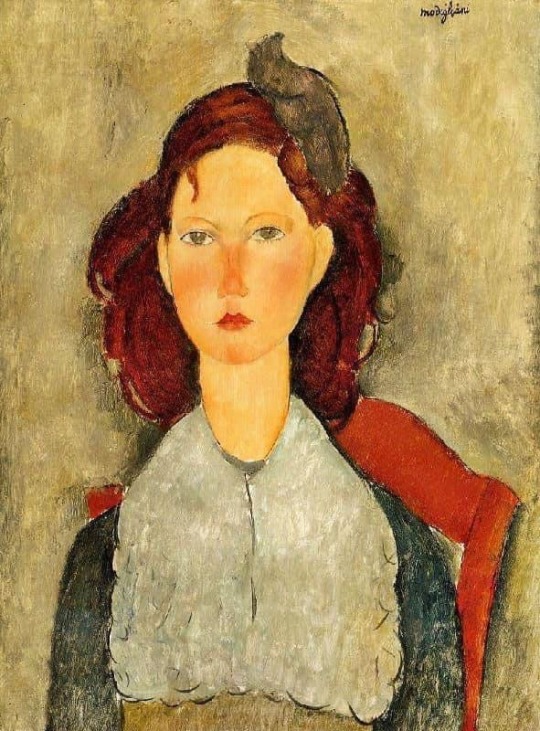
#israel#secular-jew#jewish#judaism#israeli#jerusalem#diaspora#secular jew#secularjew#islam#art#artist#artistic#painting#oil painting#amedeo modigliani#Modigliani#sephardic#sephardim#sephardi jewish
23 notes
·
View notes
Text
wonka's city
idk man i just find it interesting knowing stuff about the setting so, some observations i made of the city in wonka (i made another post about the actual filming locations, which are mostly bath, oxford and lyme regis, but this is talking abt the fictional city).

the first visible bit of the city is this hilltop and a bigass mountain to the left.

port seems to be p green with lots of house looking buildings heading up the mountain.





big breakwater/harbour wall that curves round. city gets posher the higher up the hill u get, and that looks like a castle on the hilltop we saw earlier.
fancy old gate on the main road into town, and a load of fuck off big mountains in the back.
the port's lighthouse is at the end of the breakwater (fun fact, this doesn't exist irl).

map of the main square with all its restaurants. willy knew brandino's and la parisienne without being able to read, so supposedly their p famous (willy later poses as a waiter at Cafe Heinrich). they're also the two restaurants closest to st benedict's cathedral. theres two big arches either side of the main square, one has a clocktower bell with two statues (one banging the other on the head with a frying pan) that come out cuckoo clock style. the left arch or street seems to be called sichelbrucke (translate says this means sickle bridge?) and the street to the right says "straßenbahn haltestelle" meaning "tram stop" i think.
in the middle you've got the fountain, and opposite st benedict's is the galerie gourmet: slugworth's shop is in the top right, with fickelgruber on his left and prodnose on the right. willy's shop is bottom left corner.

irl this is on the edge of a park, so i assume it's the same for this city. a big row of columns holding up the road above it next to a river. there's a lot of rivers in this part of the city (scrubitt and bleacher's territory, and probably the poor sector of the city).


scrubitt's is right next to a river and looks mostly residential.

the galerie gourmet is just barely visible from scrubitt's.

map of the zoo that i can barely see ↑ i think the black, vaguely L shaped building on the left is where the giraffe house is?

the zoo seems to be p far away from the galerie gourmet, even further than scrubitt's.
there's also the library but that's got nothing connecting it to any other part of the city really so..
the languages also seems a bit odd as i can't place which is it's main written one? there's a lot of german (entritt, giraffenhaus, straßenbahn haltestelle, etc) and a mix of italian and french. not a lot of english despite it being based on an english book, with a 90% english cast, filmed almost exclusively in england? not a criticism, just a curiosity - where is this meant to set, if it's the same country that the very english abacus crunch lives in? my gut says england but theres so much german and the only part of england i've been to that had multiple languages was wales, and can you believe it, the other language was welsh.
my best guess is that it's a (fictional) city in northern england that has a large german speaking population.
basically its a big (northern english?) city with massive mountains behind it & a cool port & a large german population.
32 notes
·
View notes